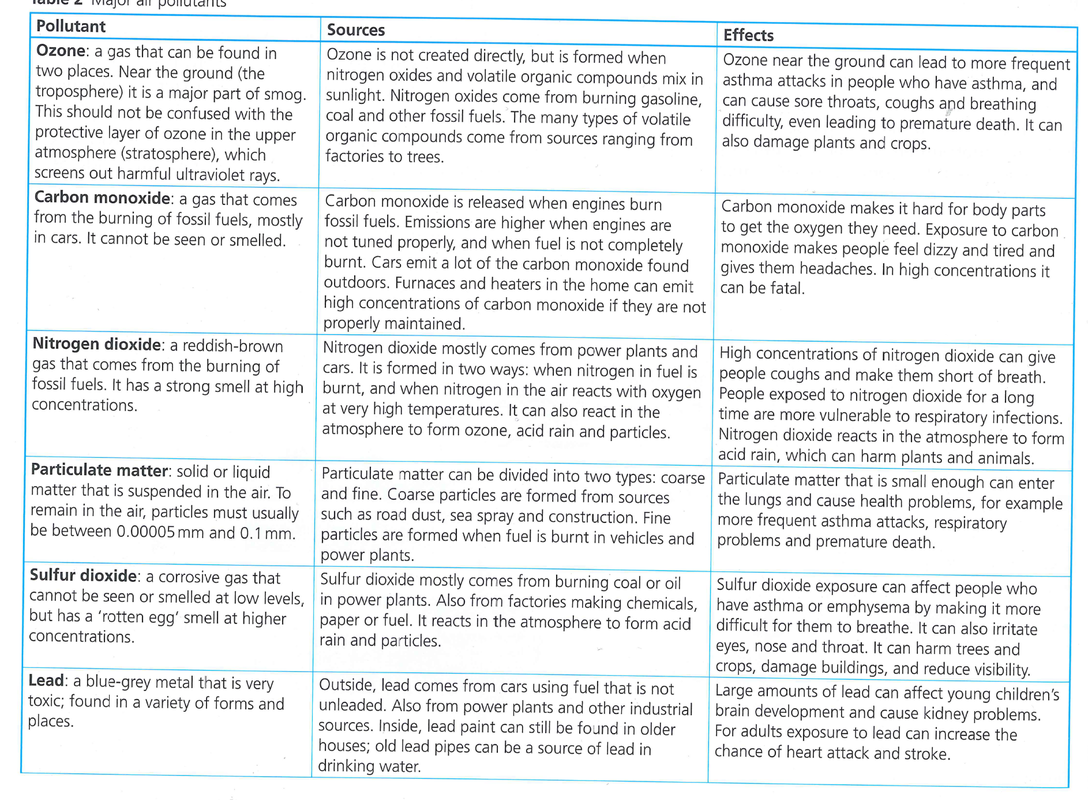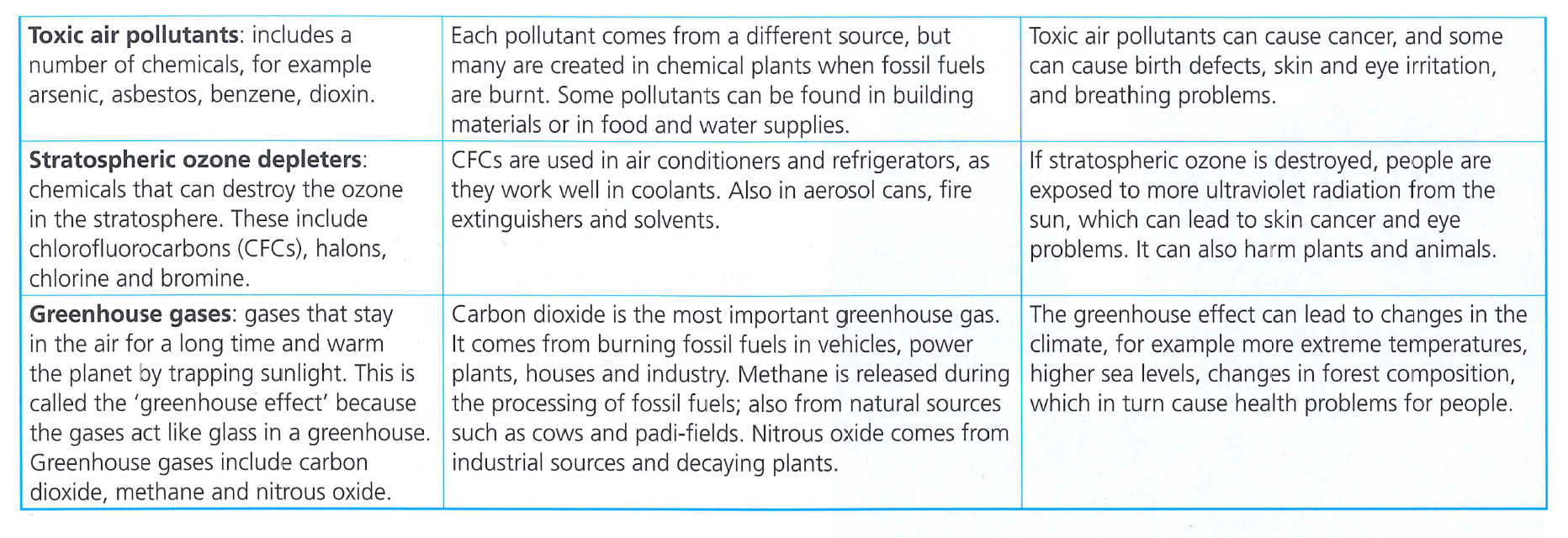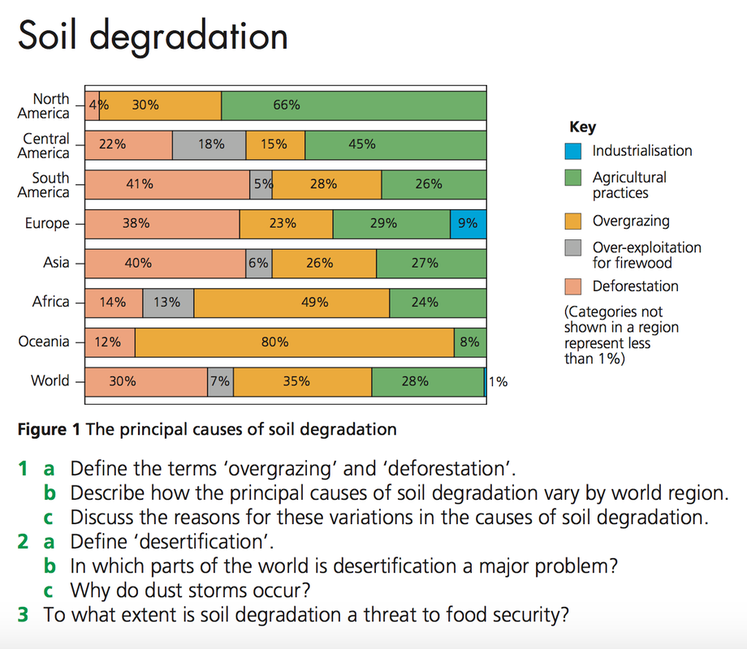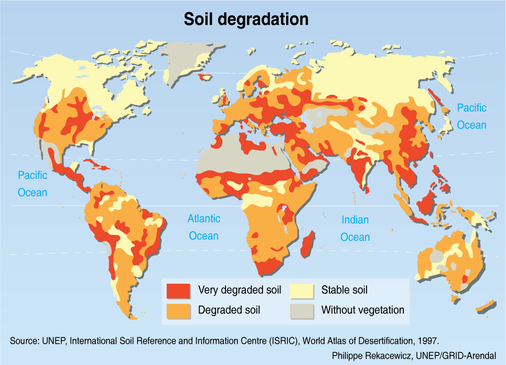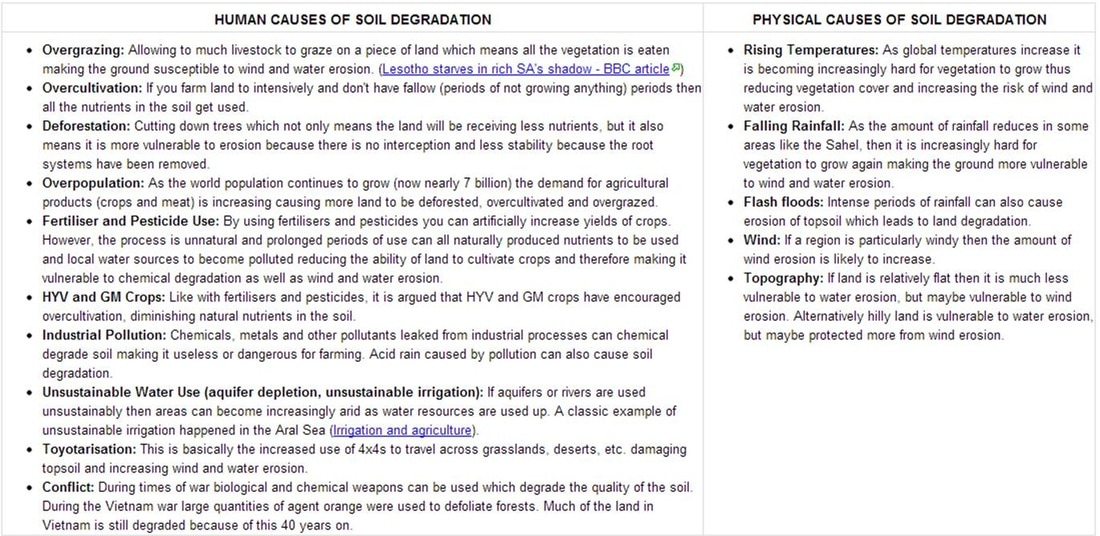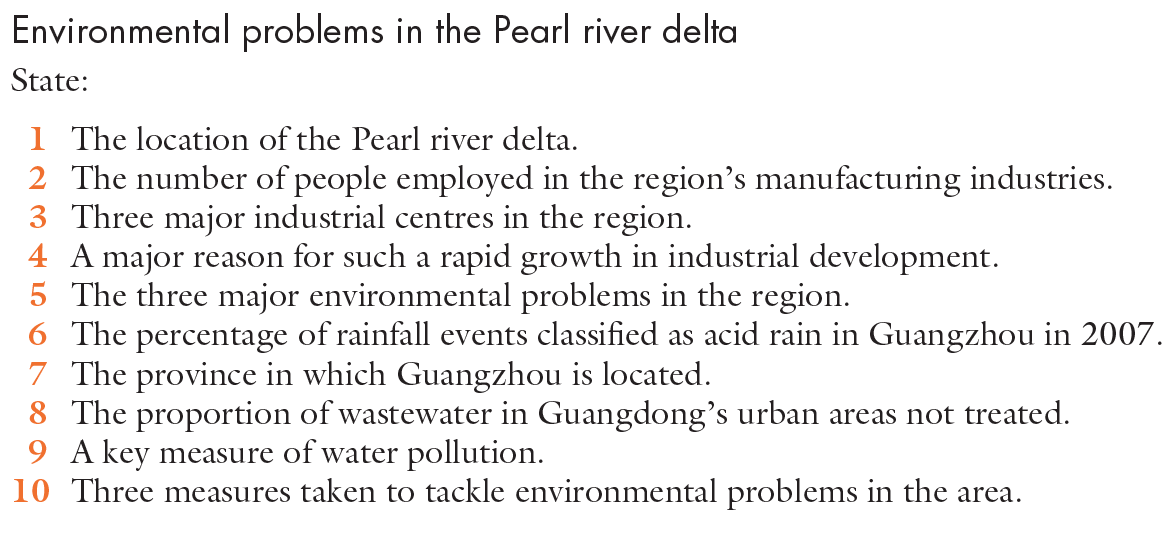Your browser does not support viewing this document. Click here to download the document.
| environment.pdf | |
| File Size: | 143 kb |
| File Type: | |
Pollution
What is it?
"The contamination of air, water, or soil by substances that are harmful to living organisms. Pollution can occur naturally, for example
through volcanic eruptions, or as the result of human activities, such as the spilling of oil or disposal of industrial waste."
"The contamination of air, water, or soil by substances that are harmful to living organisms. Pollution can occur naturally, for example
through volcanic eruptions, or as the result of human activities, such as the spilling of oil or disposal of industrial waste."
|
The main types of pollution are:
|
Pollution can be categorized into 2 different types:
|
Types of Pollution
Using the information below and your Geography textbook page 226 to 228 create a set of notes on the different types of pollution. Pay special attention to Air pollution and table 2 on page 226.
AirAccording to the dictionary, air pollution is the contamination of air by smoke and harmful gases, mainly oxides of carbon, sulfur, and nitrogen. Some examples of air pollution include:
Air pollution is linked to asthma, allergies and other respiratory illnesses. LandLand pollution is the degradation of the Earth's surface caused by a misuse of resources and improper disposal of waste. Some examples of land pollution include:
RadioactiveRadioactive pollution is rare but extremely detrimental, and even deadly, when it occurs. Because of its intensity and the difficulty of reversing damage, there are strict government regulations to control radioactive pollution.
Sources of radioactive contamination include:
|
WaterWater pollution is the contamination of any body of water (lakes, groundwater, oceans, etc). Some examples of water pollution:
These kinds of environmental pollution are linked to health issues in humans, animals and plant-life. ThermalThermal pollution is the increase of temperature caused by human activity. A few examples of this include:
These kinds of environmental pollution can cause aquatic life to suffer or die due to the increased temperature, can cause discomfort to communities dealing with higher temperatures, and will affect plant-life in and around the area. NoiseNoise pollution is any loud sounds that are either harmful or annoying to humans and animals. Some exmaples of noise pollution:
Noise pollution can be disruptive to humans' stress levels, may be harmful to unborn babies, and drives animals away by causing nervousness and decreasing their ability to hear prey or predators. It can even disrupt breeding patterns. LightLight pollution is the brightening of the night sky inhibiting the visibility of stars and planets by the use of improper lighting of communities. Some examples of what causes light pollution:
Light pollution uses more energy, may affect human health and our sleep cycles. It can also affect animal behaviour. Extra reading
| ||||||
The Green House Effect
The Green House effect: an atmospheric heating phenomenon, caused by short-wave solar radiation being readily transmitted inward through the earth's atmosphere but longer-wavelength heat radiation less readily transmitted outward, owing to its absorption by atmospheric carbon dioxide, water vapor, methane, and other gases; thus, the rising level of carbon dioxide is viewed with concern.
Global warming: a gradual increase in the overall temperature of the earth's atmosphere generally attributed to the greenhouse effect caused by increased levels of carbon dioxide, CFCs, and other pollutants. This is caused by human activity.
Climate change: a change in global or regional climate patterns, in particular a change apparent from the mid to late 20th century onwards and attributed largely to the increased levels of atmospheric carbon dioxide produced by the use of fossil fuels.
Global warming: a gradual increase in the overall temperature of the earth's atmosphere generally attributed to the greenhouse effect caused by increased levels of carbon dioxide, CFCs, and other pollutants. This is caused by human activity.
Climate change: a change in global or regional climate patterns, in particular a change apparent from the mid to late 20th century onwards and attributed largely to the increased levels of atmospheric carbon dioxide produced by the use of fossil fuels.
Climate Change
|
CHANGES IN NATURE
Changes in the seasons (such as the UK spring starting earlier, autumn starting later) are bringing changes in the behaviour of species, for example, butterflies appearing earlier in the year and birds shifting their migration patterns. |
Textbook pages 230-231
Since the last ice age, which ended about 11,000 years ago, Earth's climate has been relatively stable at about 14 °C. However, in recent years, the average temperature has been increasing. Higher temperatures Scientific research shows that the climate - that is, the average temperature of the planet's surface - has risen by 0.89 °C from 1901 to 2012. Compared with climate change patterns throughout Earth's history, the rate of temperature rise since the Industrial Revolution is extremely high. Changing rainfall There have been observed changes in precipitation, but not all areas have data over long periods. Rainfall has increased in the mid-latitudes of the northern hemisphere since the beginning of the 20th century. There are also changes between seasons in different regions. For example, the UK's summer rainfall is decreasing on average, while winter rainfall is increasing. There is also evidence that heavy rainfall events have become more intensive, especially over North America. SEA ICE Arctic sea-ice has been declining since the late 1970s, reducing by about 4%, or 0.6 million square kilometres (an area about the size of Madagascar) per decade. At the same time Antarctic sea-ice has increased, but at a slower rate of about 1.5% per decade. ICE SHEETS The Greenland and Antarctic ice sheets, which between them store the majority of the world's fresh water, are both shrinking at an accelerating rate. SEA LEVEL RISES Since 1900, sea levels have risen by about 10 cm around the UK and about 19 cm globally, on average. The rate of sea-level rise has increased in recent decades. RETREATING GLACIERS Glaciers all over the world - in the Alps, Rockies, Andes, Himalayas, Africa and Alaska - are melting and the rate of shrinkage has increased in recent decades. |
Soil erosion and desertification
- Soil erosion is a naturally occurring process that affects all landforms. In agriculture, soil erosion refers to the wearing away of a field's topsoil by the natural physical forces of water and wind or through forces associated with farming activities such as tillage.
- Soil degradation is the decline in soil quality caused by its improper use, usually for agricultural, pastural, industrial or urban purposes. Soil degradation is a serious global environmental problem and may be exacerbated by climate change.
- Desertification can result from poorly managed human intervention in the savannah. Areas of desert are created by the destruction of natural vegetation. Causes of desertification include:
- Removal of vegetation cover.
- Overgrazing.
- Uncontrolled fuel wood collection.
- Unsustainable farming practice and loss in fertility of soil.
- Excessive tree felling.
- Removal of vegetation cover.
To help answer the above questions you can refer to page 232 of your Geography Textbook
| |||||||
Case Study: Pearl River, China
Using the sources below review and answer all the following questions:
Resources:
| Chemical Pollution Pearl River | |
| File Size: | 2783 kb |
| File Type: | |
|
|
|
Your browser does not support viewing this document. Click here to download the document.
Further information - extended research
|
|
|
Sustainable development and management
|
|
|
Development: refers to the standard of living and quality of life of its human inhabitants. In this context, development is a process of change that affects people's lives. It may involve an improvement in the quality of life as perceived by the people undergoing change.
Sustainable development: is development that meets the needs of the present, without compromising the ability of future generations to meet their own needs.
Sustainable development: is development that meets the needs of the present, without compromising the ability of future generations to meet their own needs.
|
Examples of Sustainable Development
|
|

